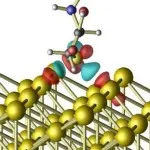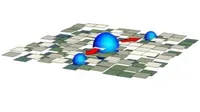Simulations

From Theory to Numbers to Insights
Whenever analytical approaches are not possible, we employ numerical methods. In-house developed codes are developed and used for the simulations. Some of them have been demonstrated to parallelize almost ideally on tens of thousands of processor cores. These codes are also combined with open source or proprietary software packages, particularly for the ab initio part and specific material properties or processes can be simulated.
Exact Quantum Dynamics
Here we address the challenge of approximation-free simulations of quantum systems. This provides benchmarks for more approximate approaches. We use so-called Matrix-Product States which is an efficient way of representing complex wave functions.
Further reading: Comms. Phys. 6, 125 (2023), J. Phys. Mater. (2023), J. Chem. Theory Comput. (2024).
Transverse Transport Phenomena and General Linear Response Phenomena
The former are unconventional responses in the sense that they are perpendicular to the applied external fields. Examples include Hall effects, Spin-Hall effects, Anomaleous Quantum-Hall effect, or transverse thermoelectric effects (Nernst effect) etc. We are developing linear-scaling approaches to simulate such transverse transport on a large scale (millions of orbitals or atoms) which allows to have unprecedented insight into the underlying physics. Connected to the above research topic, we have developed a generalized approach to describe a large class of response functions in a recent work Phys. Rev. Lett. (2021).
Further reading: Phys. Rev. Lett. (2013), Phys. Rev. B (2015), Phys. Rev. Lett. (2021), Phys. Rev. B (2024).
Linear Scaling Wannier Optics
Optical properties of semiconductors are usually affected by excitonic effects, which can be described in the Bethe-Salpeter framework. We are developping tools to bring down the computational effort for this framework.

Ab Initio Description of Materials
The variety of materials need to be described on the ab initio level to simulate their specific properties. We use density functional theory and time-dependent density functional theory for the simulations of various electronic parameters and optical spectra. Molecular dynamics, many-body perturbation theory and wave function-based methods complete the set of approaches used.

Ultrafast Dynamics, Transport and Localization
Transport phenomena from the femtosecond to the nanosecond timescale are being explored. We develop efficient (ideally linear-scaling) approaches and implement them in our codes.
Further reading: EPL 2011, Phys. Rev. Lett. 2013, Nano Lett. 2013, 2D Mater 2014, Phys. Rep. 2021, J. Phys. Mater. 2022